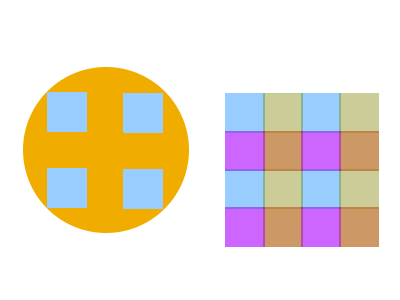Focal plane
The WFCAM instrument has been designed to maximise survey speed, and
the camera has four Rockwell Hawaii-II 20482 PACE arrays,
with a large pixel scale of 0.4''. A single exposure covers a solid
angle of 0.207 sq. degs. Because the arrays are not buttable, they
are arranged with 94% spacing (revised from 90%), as shown in Fig. 1
(LHS). This requires a focal plane of diameter 1 deg. As illustrated
in Fig. 1 (RHS), a filled square is achieved with four pointings.

Figure 1. Left: Focal plane arrangement of
WFCAM. Each array is 2048X2048 pixels, with pixel size 0.4''. The
spacing between arrays is 0.94 times the detector width. The
instantaneous coverage is 0.207 sq. degs. Right:
Filled-in tile after 2X2 macrosteps. Allowing for overlaps with
adjacent tiles,the width of a single tile is 3.88 detector widths,
i.e. 0.883 degs, giving a solid angle of 0.78 sq. degs.
The large pixel size means that the typical seeing at UKIRT (<0.6'')
will be undersampled. To improve the image sampling, a 2X2
microstepping sequence, with step size N+0.5 pixels, will be
employed. The data will then be interlaced (i.e. keeping the
pixels independent) into a grid of pixel spacing 0.2'', producing a
4096X4096 pixels image for each array. In fact, in order to minimise
the number of bad pixels in the final images, this will be repeated
after a small offset, and the data averaged. The standard exposure
will be 5 sec., so that the standard total integration time for a
pointing is 40 sec. To summarise: a pointing is made up of a set of 8
(2X2X2) 5 sec. exposures, and results in 4X4096X4096 images written to
disk, in which a pixel is exposed for 10 sec. The pointing is the basic
unit of the surveys, and defines the minimum depth. A set of four
pointings on a 2X2 grid of macrosteps, fills in a tile of solid angle
0.77 sq. degs. Increased depth is built up in a series of passes.
